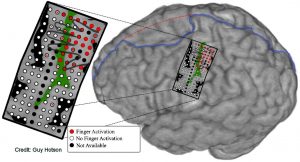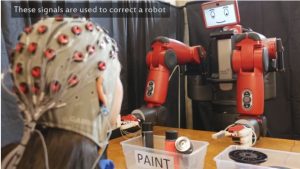In one sense of course, Human Machine Interface has been around since the invention of the wheel. Over the last twenty years however progress has been particularly rapid and Human Machine Interface has become both very advanced and quite intimate.
Much of the progress has taken place in the design and development of prosthetic devices to replace body parts lost by disease, injury or congenital condition. Modern materials along with engineering design and miniature electronics have produced artificial limbs that can function nearly as well as a limb of flesh and blood.
Some of the best available technology today employs the residual nerve signals or muscle contractions that would have controlled the missing limb to now control the movements of a myoelectric prosthesis. These devices have enabled thousands of people to regain the better part of the functioning of their lost limb. The picture below shoes a basic layout of a myoelectric artificial arm and hand.

Some of the most advanced work is now being accomplished by John Hopkins Medicine and involves a direct control of a prosthetic limb by the mind itself. To read the brain’s signals a sensor pad with 128 electrodes is surgically implanted on the region of the brain that controls arm and hand movement. The sensory data is then analyzed by a computer which then controls a robotic hand. The team that is conducting the research claim that they can reproduce 88% of the functioning of a normal hand with the test subject being able to individually move the robotic thumb and fingers. The picture below shows the sensor pad and where it was implanted on the brain.

If you’d like to read more about the research being conducted at John Hopkins click on the link below.
Another project taking place at MIT involves actual mind control of a robot. The picture below shows the experimental setup.

In the experiment a human subject places a skullcap over their head which measures their brainwaves. The brainwaves are then analyzed by a computer which uses them to control a robot. In the experiment the robot is carrying out a simple task of sorting objects into one of two bins. So far the researchers are successful in commanding the robot into which bin to place the object with only their brains 70% of the time so we have a way to go before we can make robots dance just by thinking them to do so but it is a start. If you’d like to read more about the research at MIT click on the link below.
http://www.wbur.org/bostonomix/2017/03/08/mit-mind-controlled-robots
In some respects human control of what machines are capable of doing is almost a definition of technology. We’ve been getting better at it for thousands of years but progress is accelerating and what we may be capable of in just a few decades is staggering.

It’s challenging to locate well informed individuals on this issue, but you
seem like you realize what you’re talking
about! Thanks
Thanks for the comment and tell all your friends!
Bob L
I adore it when people come together and share opinions, great
blog, keep it up.
I’ll do my best if you keep coming back. Thanks for the comment.
Bob L
I adore it when people come together and share views, great blog, keep it up.
Thanks for the comment and I hope you come back soon.
Bob L
According to Value Market Research, the latest technology trends and global market opportunity analysis in the Human Machine Interface Market industry growing with a high CAGR in the upcoming year. Our report has categorized the market based on technology, service, development, vertical and region.
While I don’t usually approve comments that are connected to businesses since yours is definitely connection to the topic of the post I’ll allow it. Looks like an interesting website!!
Bob L